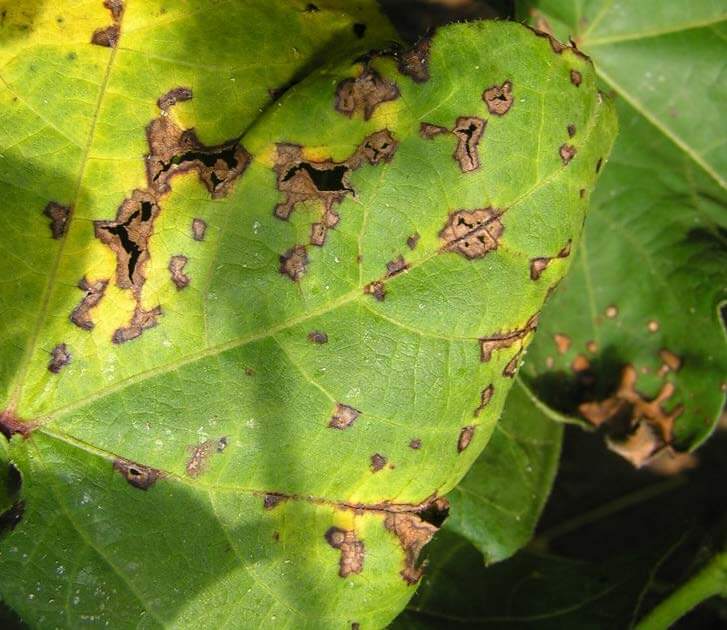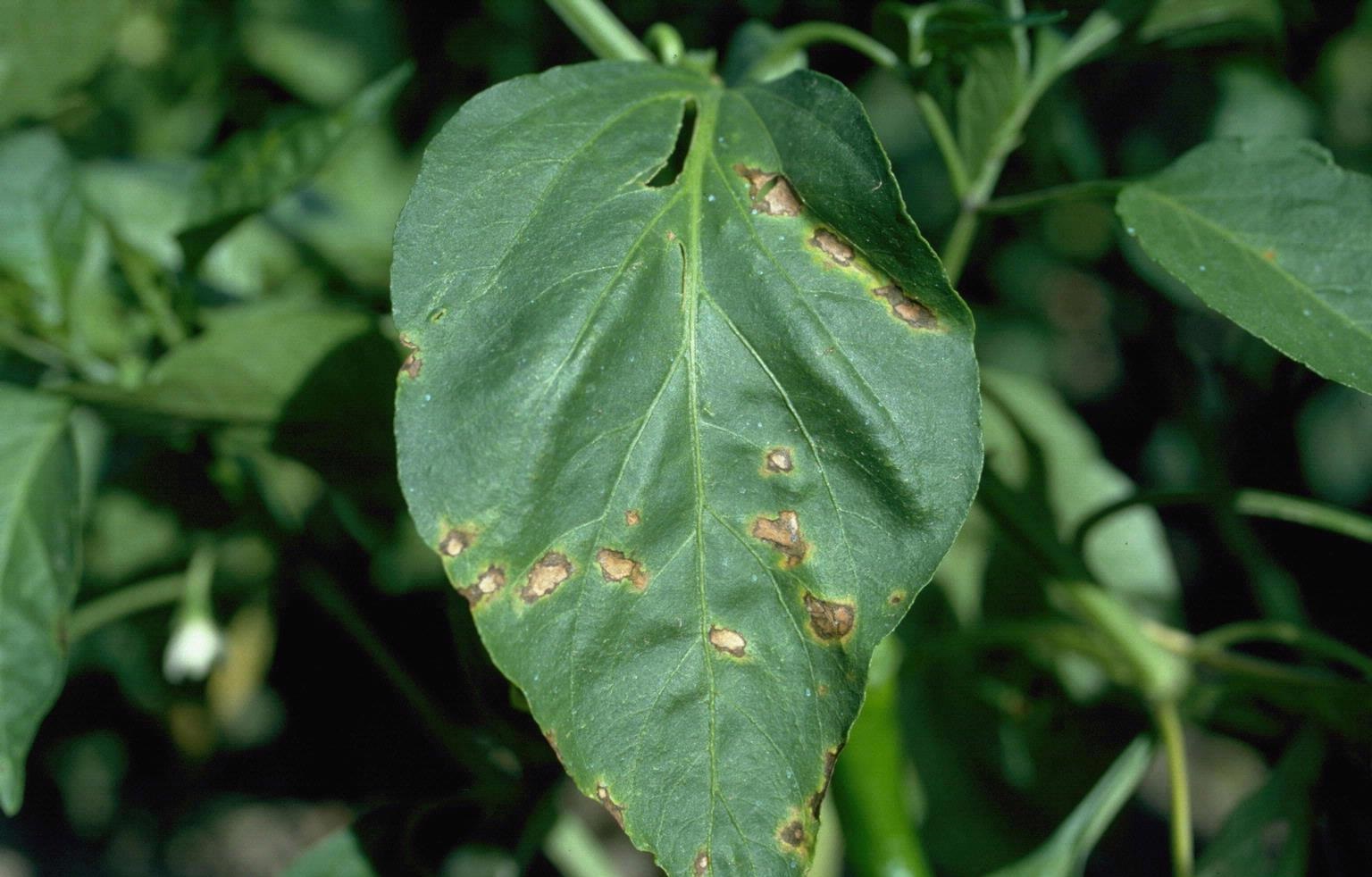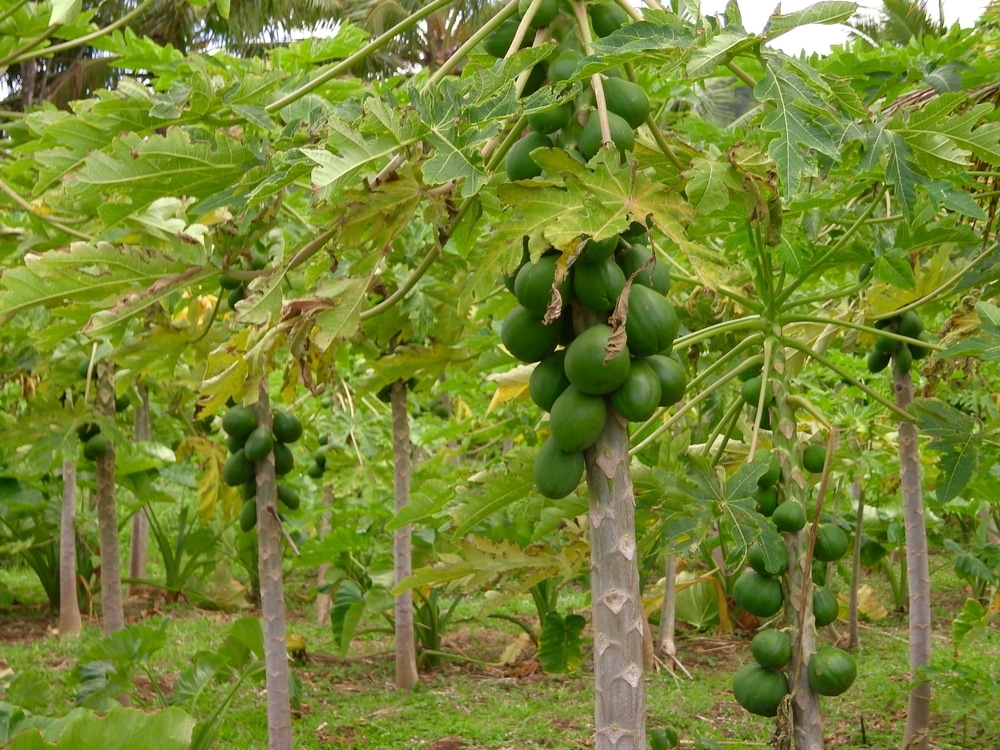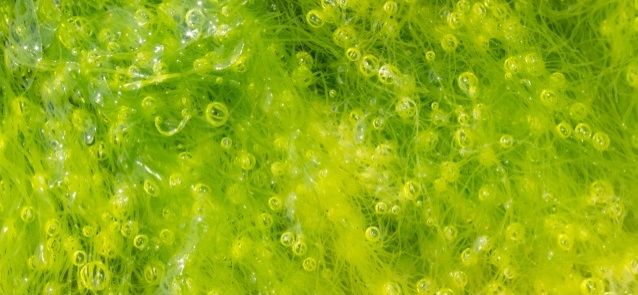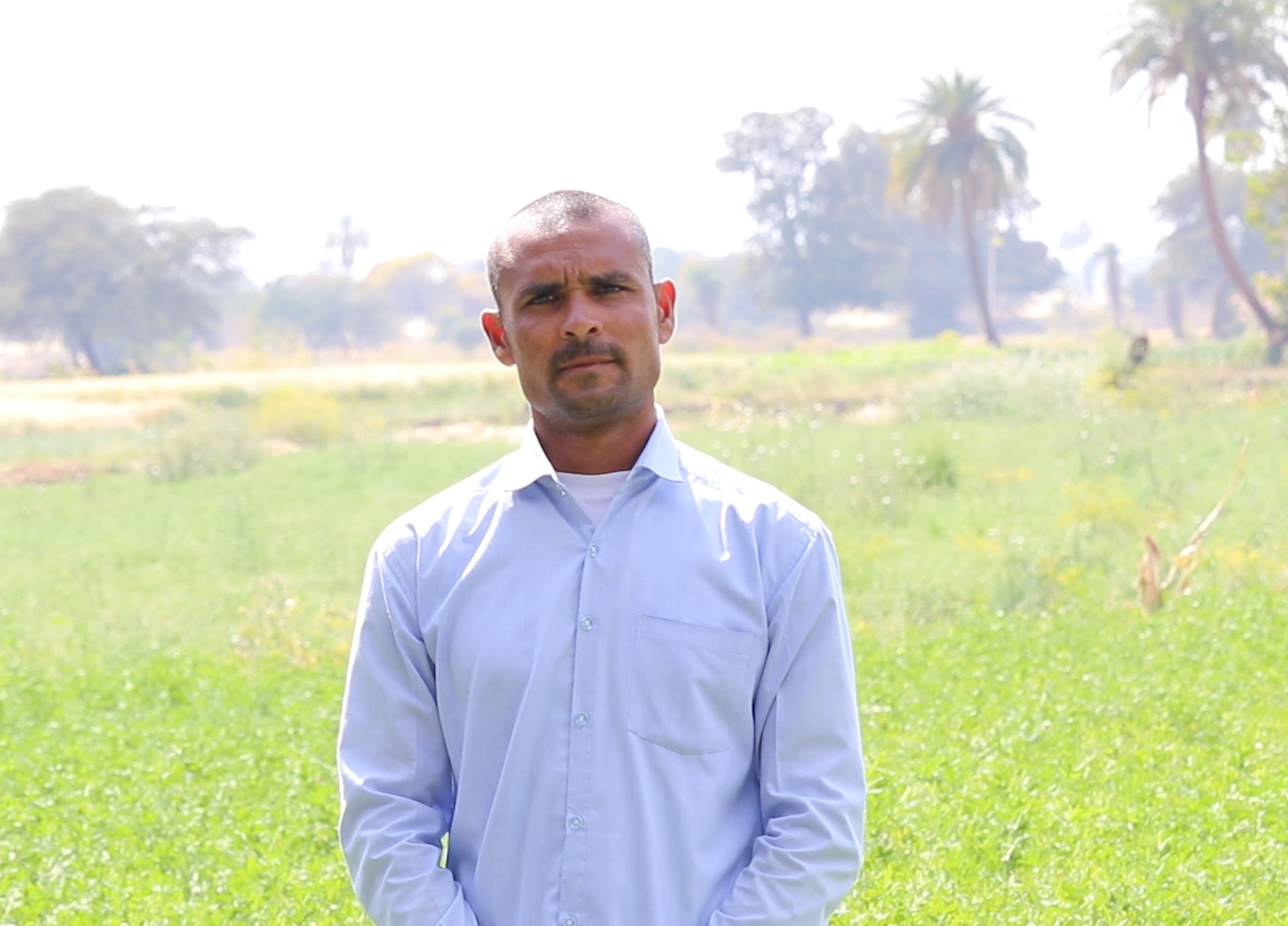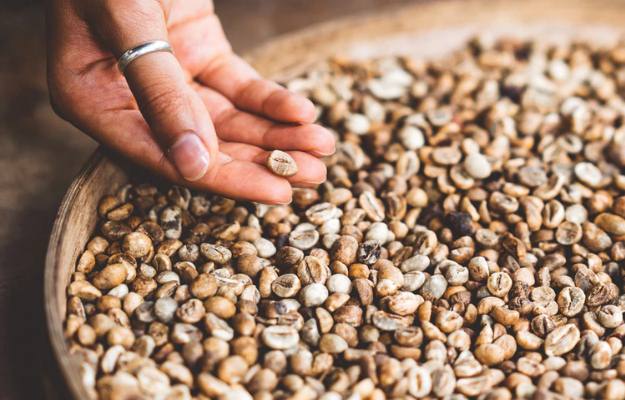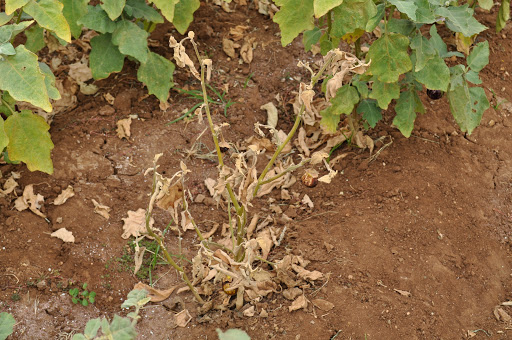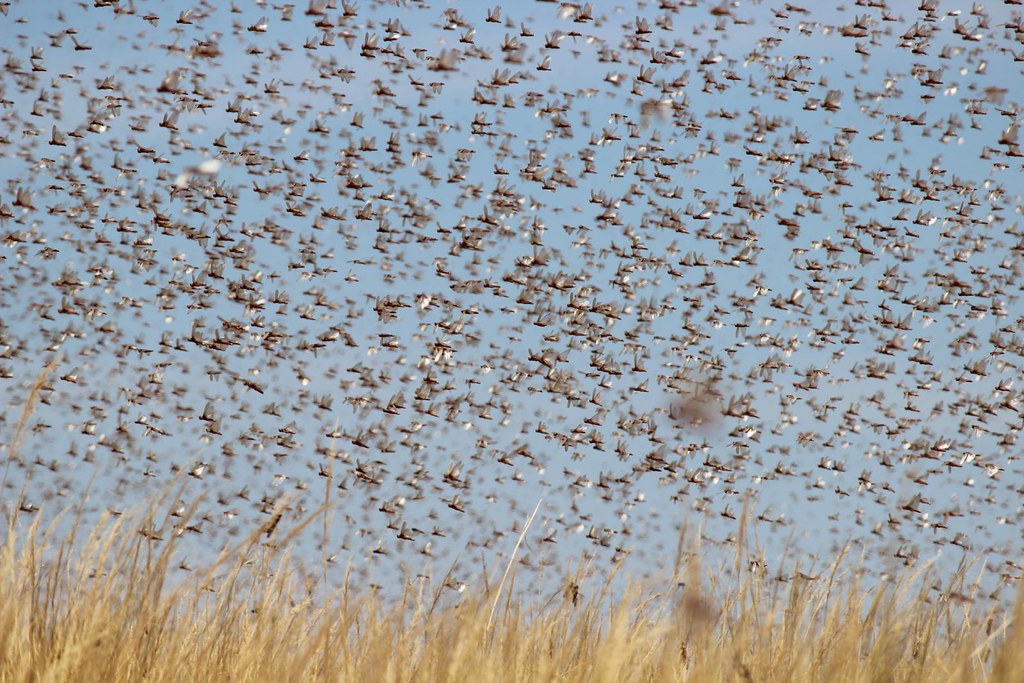- Bacterial scorching disease can affect any part of the infected plant and any stage of plant growth.
- In the early stages of plant growth, submerged, spherical or irregular wounds spread to the stem and eventually die of withering and sprout which is known as seedling blight.
- Small, dark green, submerged angular spots first develop on the lower surface of the leaves, gradually these spots grow dark brown and later these spots appear on the surface of both leaves, called the angular leaf spot.
- In this, the veins of the leaves turn black and the leaves start to appear wrinkled and twisted. Which is called vein necrosis.
- Black wounds on the trunk and branches and premature fall of leaves is a symptom known as Black Arm.
- In this disease, rotten seeds and fibers become colorless in the bolls. In the infected boll, the angular round submerged spots appear which become pitted and dark brown or black over time, this is called Boll rot.
Know the symptoms of Bacterial leaf spot disease in Chilli crop
- The first symptoms appear as small yellowish-green spots on the new leaves and these leaves are deformed and twisted.
- Later on, the leaves show small circular or irregular, dark brown or black smooth spots. As these spots grow in size, the middle part becomes lighter and the outer part becomes darker.
- Finally, these spots turn into holes because the middle part of the leaves dries up and bursts.
- In severe infection, the affected leaves fall prematurely.
- Submerged spots form round, bulging, yellow edges on the fruit.
There may be Rain in the next two days from Pre Monsoon, Monsoon will come on time
The Monsoon will knock in Kerala from its scheduled time of June 2 to 9 and then make it rain in different parts of the country. Meanwhile, the head of Indian Meteorological Department, Mrityunjay Mohapatra has said that there is a possibility of widespread rains in India for the next few days under the pre-monsoon before the onset of monsoon.
The effect of the pre-monsoon has been seen since the night of 29 May and there is a possibility that due to this, some states may receive heavy rains by 31 May. Madhya Pradesh, Western Himalayas, Jammu and Kashmir, Ladakh, Himachal Pradesh and Uttarakhand are likely to be affected by these pre-monsoon rains. Apart from this, there is a possibility of rain in West Bengal, Odisha, Karnataka, Punjab, Haryana, Chandigarh and Delhi.
In the coming 24 hours, especially in North Punjab, Haryana, West Uttar Pradesh and some areas of Delhi, a dust storm or thunderstorm accompanied by light rain is expected. During the next 24 hours, rain activities are possible in many parts of Bihar and eastern parts of Jharkhand in West Bengal. Light rain is expected at some places in Uttar Pradesh and Odisha.
Source: Nai Dunia
ShareSymptoms of Iron deficiency in Papaya plants
- Iron deficiency first appears on new leaves. In this, the upper leaves turn yellow but the veins remain green.
- In the later stages, if no remedy is taken, the entire leaf becomes white-yellow and brown sore spots appear on the leaf surface.
- This reduces the rate of photosynthesis, due to which the plant is not able to make food and the yield potential of the plant is reduced.
- Its deficiency can be overcome by spraying 15 grams of Chilled Iron in a tank of 15 liters of water and spraying it on the leaves. or
- Ferrous Sulphate (Fe 19%)
Importance of Seaweed in Crops
- Seaweed works as an increase in plant metabolism, it stimulates internal growth and development processes in plants.
- Along with the initial germination growth, primary and secondary root growth occurs.
- Seaweed increases the activity of microorganisms. Which improves the soil structure.
- Due to this, plants get high amounts of nutrients, which leads to better growth of leaves and branches.
- Reduces the fall of flowers and fruits in the crop.
- Increasing the size of grains and fruits and increasing weight increases the quality of the crop with a higher yield.
Soybean cultivation became profitable for Vishnu Thakur with the help of Gramophone
Vishnu Thakur, a farmer from Birgoda village of Depalpur tehsil of Indore district, has been cultivating for the last 10 years and mainly cultivates crops like soybean, wheat, gram, garlic, potato. Vishnu was troubled by diseases caused in his crops during farming and due to this, he could not get good production from his crop.
When Vishnu was troubled by these problems related to his crops, he came to know about Gramophone and joined it. After connecting with Gramophone, his problems began to be diagnosed. Talking about this, he told Team Gramophone that “My crops have improved after joining Gramophone. Earlier my crops used to be like a loss deal or ‘no profit no loss’, now it is giving profits. Vishnu believes that the Gramophone has made farming a ‘profit business’.
However, Gramophone helped Vishnu to get rid of his troubles. As a result, his soybean production was almost double that of the previous production. While Vishnu first earned a profit of Rs 195000 from soybean cultivation, after joining Gramophone, this profit increased to Rs 380000.
If you too are facing some kind of problem regarding your farming, then like Vishnu, you too can get a diagnosis of your problems by connecting with Gramophone. To connect with Gramophone, you can make a missed call on the toll-free number 1800-315-7566 or login to the Gramophone Krishi Mitra app.
ShareAmphan like storms coming from Arabian Sea, crops can suffer huge losses
The news of the huge loss of farmers due to the storm of Amphon in West Bengal and Odisha was just going on. Suddenly another cyclone is now coming in the Arabian Sea near the southwestern state of Kerala. Apart from western states, the impact of this storm can be seen in some parts of Uttar Pradesh and Madhya Pradesh. It can also cause heavy damage to crops.
According to agricultural experts, the worst effect of this cyclone could be on Gujarat. Although the Indian Meteorological Department has not said anything clear about the cyclone at the moment, it has said that if the situation does not improve in the next five days, there is a possibility of a severe cyclone. According to the Meteorological Department, it would be right to say anything on this subject only after May 30, but people need to be vigilant.
Source: Krishi Jagran
ShareChironji is full of medicinal properties
- Chironji is found inadequate amounts of protein, also contains vitamin C, vitamin B1, vitamin B2.
- B1, B3 found in Chironji increases hair growth.
- Chironji is a very effective beauty product. It brings the glow to the face and clears out pimples. If there is a stain on the face, then grinding it and applying it to the affected area makes the face spotless.
- At the same time, amino acids and stearic acid are also found in the oil made from it.
- Consumption of Chironji strengthens the digestive system and the problem of digestive constipation is eliminated.
Measures to protect the Brinjal crop from bacterial wilt disease
- Keep fields clean, and collect infected plants and destroy them.
- This disease can be controlled by adopting crops like cauliflower, cabbage, mustard, radish in the crop cycle.
- Pant Samrat variety is tolerant to this disease.
- For prevention of this disease, Kasugamycin 5% + Copper oxychloride 45% WP @ 300 gm or Streptomycin sulfate IP 90% + tetracycline hydrochloride 10% W / W @ 20 gm or Kasugamycin 3% SL @ 300 ml per acre mixed in 200 liters of water and drenching near the roots. Or
- Drenching near plant roots by mixing Kasugamycin 5% + Copper oxychloride 45% WP @ 250 grams per acre in 200 liters of water.
Madhya Pradesh Agriculture Minister announced compensation in view of large attack of locust party
Crop’s biggest enemy locust team has knocked In many areas of Rajasthan, Madhya Pradesh, and Uttar Pradesh. Officials of the Agriculture Department say that such a big attack of locusts has occurred especially in Madhya Pradesh after 27 years. Given this large locust attack, precautionary steps are also being taken by the government.
On this issue, Agriculture Minister of Madhya Pradesh Shri Kamal Patel said that a survey of the losses caused to farmers due to the locust outbreak will be conducted. The survey work will be done by forming a joint team of staff of the Revenue Department and Agriculture Department. In this survey, the farmers who have suffered a significant loss will be compensated under RBC 6 (4). Along with this, Minister Shri Kamal Patel said that the necessary instructions for this from the state level should also be issued soon.
Source: Nai Dunia
Share
